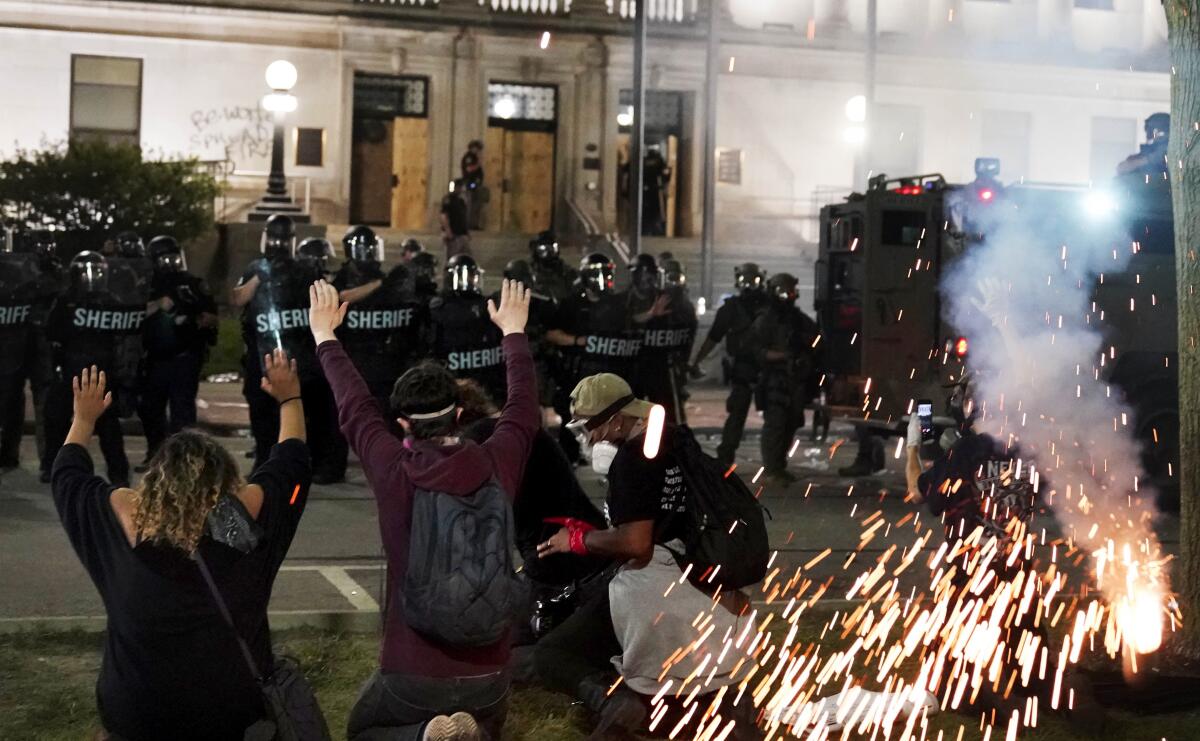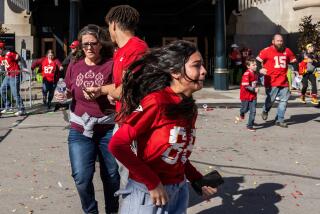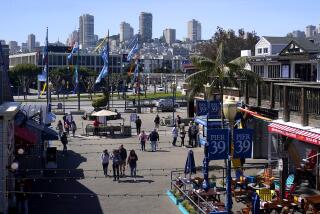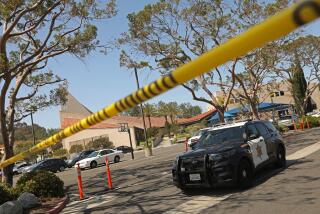Shooting deaths in Kenosha seemed tragically inevitable

- Share via
The tragedy unfolding in Kenosha, Wis., worsened overnight in ways that are at once shocking but also seemingly inevitable. Two people were shot dead and another wounded as protesters and self-styled militiamen faced off during a third night of street demonstrations after police on Sunday shot and gravely wounded yet another apparently unarmed Black man, Jacob Blake.
Details of the latest violence remain sketchy Wednesday morning, but videos and photographs show verbal confrontations between protesters and heavily armed volunteers who said they were trying to protect a gas station in the area racked by vandalism, theft and arson the previous night. “They’re a militia,” Kenosha County Sheriff David Beth told reporters. “They’re like a vigilante group.”
In one of the videos, a young white man carrying a military-style rifle can be seen running down a street pursued by a small group of people as one person yells, “He shot someone!” One man knocks the gunman to the ground, and in the scuffle the gunman opens fire, appearing to hit two people at close range. He then gets back onto his feet and walks calmly down the road toward emergency vehicles. Police later reported the arrest of Kyle Rittenhouse, 17, in Lake County, Ill., in connection with the deaths.
So why does this escalation of violence seem inevitable? Because of the guns.
Protests have roiled the nation for three months now following the death of George Floyd in the custody of Minneapolis police and the shooting death of Breonna Taylor during a police raid in Louisville, Ky. Those protests have at times turned destructive and violent, which is bad enough. But there’s been a lethal element too — the slayings in Kenosha add to at least a dozen others connected with protests across more than 100 cities this summer, an emotional outpouring of frustration over the nation’s inability to counter anti-Black racism.
Self-styled militias have also shown up at sites of peaceful protests in organized and unwelcome displays of firepower, ostensibly to protect life and property but in reality just ratcheting up tension with their overt attempts at intimidation. The militias aren’t the cause of all or even most of the violence, of course, but their presence is an unnecessary infusion of yet more volatility.
In Albuquerque, a 31-year-old man, part of a group intending to stop demonstrators from harming a statue of Spanish conquistador Juan de Oñate, was arrested in June after allegedly shooting and wounding one of the protesters. The same month, police here in California charged an Air Force sergeant affiliated with the “boogaloo” movement — right-wing provocateurs intent on fomenting civil war — in the shooting deaths of a federal security guard in Oakland and a Santa Cruz sheriff’s deputy.
Meanwhile, the restrictions imposed by state and local governments to slow the spread of COVID-19 fueled their own strain of frustration and tension, prompting a separate set of anti-government demonstrations. In several places, protests have included the open display of firearms by people (nearly all men), most notoriously in the halls of the Michigan State Capitol.
This is democracy in action: Peaceful protests against institutional racism and the deaths of unarmed Black people at the hands of police. Peaceful protests against statues erected to venerate the nation’s white supremacist roots. Peaceful protests against public health orders. And counterprotests against all those other protests. Voices raised together to demand change, to defend the status quo, to complain about government actions or to make whatever other point they might want in the free exercise of their 1st Amendment rights.
But then, violence.
There is, of course, plenty of blame to go around. Protesters shouldn’t resort to vandalism — at least 34 fires have been set in Kenosha since Blake was shot on Sunday — and opposing sides in a public debate shouldn’t start pushing, shoving and swinging signs at each other.
But they do. And the introduction of firearms into such scenes makes it almost inevitable that a gun will eventually get used.
The details will, of course, frame our understanding of what happened in Kenosha. But what is already clear is that self-styled militia, or civilian patrols, or whatever they want to call themselves, have no business assigning themselves the armed defenders of the public peace.
As we’ve seen over and over again, as a society we have yet to properly balance the role of the trained police in maintaining public safety in this country. Adding armed vigilantes to the mix just elevates tensions and increases the likelihood that violence will spin off in ever wider and consuming circles.
More to Read
A cure for the common opinion
Get thought-provoking perspectives with our weekly newsletter.
You may occasionally receive promotional content from the Los Angeles Times.






